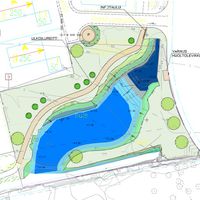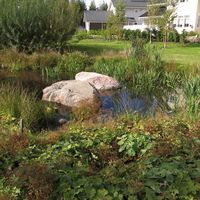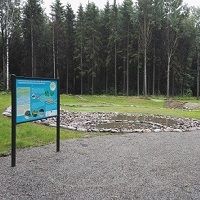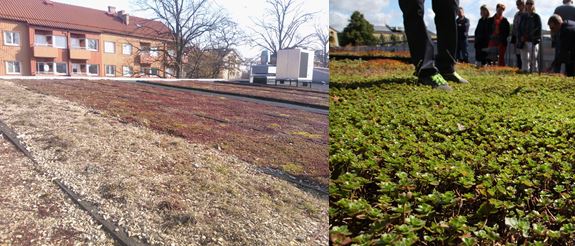Information
Information
Stormwater is rain and melting water collected in urban areas from hard surfaces, such as asphalt and roofs, where it cannot infiltrate the ground. Water of other origins, such as firefighting and tunnel or street rinsing water, may also end up in the stormwater management system. Stormwater often pollutes local water systems, as it may be contaminated by high amounts of solids and harmful substances originating from sources such as traffic.
As rainfall and cloudbursts due to climate change increase and urban construction becomes denser, green surfaces, which rainwater can infiltrate, are decreasing in size and traditional stormwater management based on leading water into pipes is becoming insufficient. Urban flooding has therefore become a common problem, causing safety risks and extensive damage with high repair costs.
Why is there a problem?
- Increasing rainfalls and cloudbursts due to climate change will increase stormwater amounts
- Traditional storm water pipe solutions are insufficient for handling the increasing amounts of
- Condensed and paved urban structures cause a lack of green space for water infiltration
- Information and guidelines in support of decision-making are lacking on the quality of stormwater and the various kinds of sustainable solutions and their functions
What is the problem?
Urban flooding: Because the present pipe solutions cannot handle the increasing amounts of water due to the lack of green space allowing infiltration, increased amounts of water are causing streets and basements in cities to flood, leading to serious safety risks and high repair costs.
Waste water overflows: In several city centres, stormwater is still fed through combined pipes (channelling both waste and stormwater). When these pipes are overloaded due to increasing amounts of stormwater, wastewater and stormwater are channelled into local water systems.
Contamination of storm waters and local water systems: When collected from paved substances such as asphalt, hazardous substances and nutrients originating in traffic and artificial materials contaminate the water in the surrounding area. In addition, faster drainage occurs due to the cloudburst erosion of sediments. If stormwater does not infiltrate the ground but is channelled by pipes into the nearest water system, these substances have a polluting impact
Decreasing groundwater table: As storm water is prevented from infiltrating the ground due to paved surfaces, the groundwater table is decreasing which causes the ground to become brittle, reducing the construction options
Examples
Examples
In the map below, you can find examples of water protection measures within this topic. These actions are picked from the Bank of Actions – if you are interested to browse for other water protection actions, visit the Bank of Actions.
![]() Agriculture
Agriculture
![]() Awareness raising
Awareness raising
![]() Hazardous materials
Hazardous materials
![]() Littering etc.
Littering etc.
![]() Oil spill prevention
Oil spill prevention
![]() Research and monitoring
Research and monitoring
![]() Shipping and boating
Shipping and boating
![]() Stormwater management
Stormwater management
![]() Strategies and programs
Strategies and programs
![]() Wastewater management
Wastewater management
![]() Other
Other
![]() Drainage basin
Drainage basin
Guidelines & Recommendations
Guidelines & Recommendations
Sustainable stormwater management
Through sustainable stormwater management, water is regarded and used as a resource. Sustainable solutions aim at water infiltration in the place where water is created, or channel it via open systems to the closest location in which it can filtrate or be connected to a water system. The benefits of sustainable stormwater management are as follows:
- provides both quantity (flooding and erosion) and quality (pollutants) control of stormwater
- the run-off time for rain is prolonged and flooding is prevented
- green and blue spots used for water infiltration form green city infrastructures and can be used by inhabitants for recreational purposes and general wellbeing
- the quality of stormwater improves, particularly when the water infiltrates the ground, because hazardous substances and nutrients are filtrated by vegetation and gravel. In addition, wastewater overflows are prevented when the water does not enter combined pipes
- groundwater resources remain stable when the water is allowed to filtrate
In order to handle water in a sustainable manner, stormwater management should be considered in all planning-related processes, beginning with the general city planning phase. Stormwater management should therefore be a natural part of land-use and construction processes and the drainage area should be taken into account as an entity. In support of comprehensive stormwater management, several cities have formed internal cross-sectoral working groups and are striving to achieve an integrated stormwater management approach aimed at the continuous evaluation and improvement of such work.
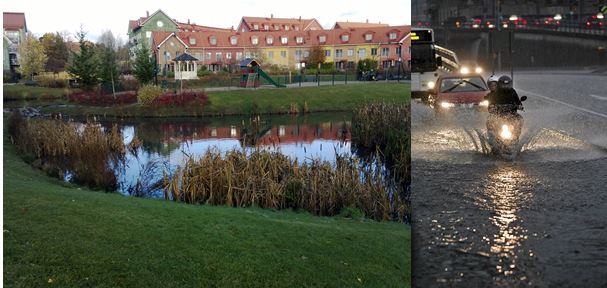
Sustainable stormwater management brings recreational opportunities and general wellbeing (left) while insufficient pipe solutions increase the risk of urban flooding (right) and substantial damage costs (Photos Eliisa Punttila and City of Helsinki Public Works Department)
Sustainable stormwater solutions
Ponds, creeks, parks and green roofs are just a few examples of sustainable ways of handling rain water while increasing the wellbeing of inhabitants and the value of urban areas. However, there is no single, definitive stormwater solution that would work anywhere. All locations are different; they have varying local problems requiring varying solutions. Determining the right solutions for stormwater management should always begin with understanding the special characteristics of an area.
Furthermore, sustainable stormwater management is usually best achieved using a combination of several methods rather than building a single, large structure. Smaller solutions are also easier to execute in densely built city areas where space is scarce and construction and maintenance costs are spread more evenly between residents and throughout the city.
Best of all, solutions not only exist for large residential areas or municipally administrated public spaces, but also for ordinary homeowners. These include preferring green surfaces by not adding concrete or asphalt to yards, using stormwater for watering plants and building rain gardens or even green roofs! Even small measures such as planting a tree in your garden count as types of stormwater management!
Reducing/ prohibiting the formation of stormwater
Green structures and permeable substrates
The easiest stormwater management solution leaves enough permeable space to prevent stormwater from forming, and thereby managing storm water as close as possible to its source.
Ways of reducing the formation of stormwater:
- Green spaces such as lawns, trees, bushes and vegetation of all kinds. As much of the existing vegetation as possible should be preserved when building. Large trees in particular are valuable since they use a great deal of water.
- Permeable paving and gravel surfaces on roads and parking lots
- Green roofs and roof gardens. Vegetation on roofs uses and detains stormwater.
- Collecting and using stormwater on site. For example, collecting water from a roof into barrels and using it to water a garden.
Channelling stormwater
Ditches, swales and channels
Channelling stormwater in open sustainable management systems prevents flooding more effectively than traditional closed pipe systems. An open system slows run-off and provides increased space during cloudbursts, thereby reducing the probability of flooding. Furthermore, slowly moving stormwater has less momentum, which reduces erosion. Sustainable stormwater solutions for channelling water can easily be combined with other management systems, such as vegetated wetlands, which may help to reduce pollution and nutrients and increase water quality in city brooks and ditches.
Ways of channelling stormwater in an open system:
- Ditches are the most traditional way of channelling water. They are suitable for less densely constructed areas, because they tend to require space.
- Swales are shallow depressions used to lead surface water away. These are often grass covered and only fill with water during rain
- Channels are more structured than ditches and more suitable for dense inner city areas
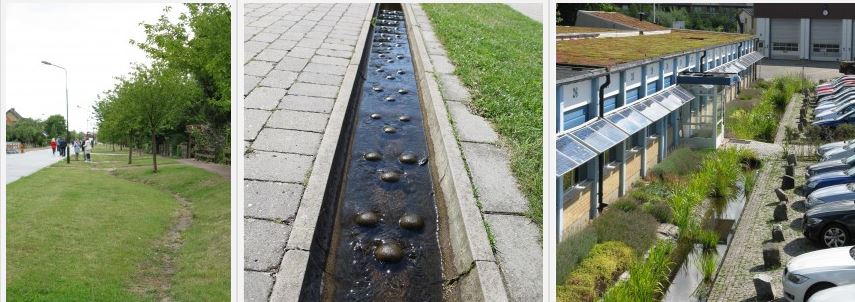
Vegetated ditches and constructed channells used for leading and retaining stormwater (Photos Tina Nyfors and Anna Räisänen)
Storage, infiltration and purification in wetlands, ponds and biofiltration areas
Wetlands and ponds
Ponds and wetlands are suitable for storing and retaining water. They are also beautiful water features that make an area more attractive. Larger structures provide valuable flood control in city areas due to their capacity to hold large amounts of water during cloudbursts. Because ponds and wetlands need space, space reservations for these should be included in the early planning phase.
Besides helping to control water quantities, larger management structures improve water quality. These solutions are able to clean water based on microbiological processes supported by vegetation and by slowing down stormwater, which allows suspended solids to sink to the bottom. Wetlands and ponds also provide living areas for many species and increase biodiversity.
If the quantity of water is the problem, rather than poor quality, flood control is also possible without ponds and wetlands; the key issue is to provide a space into which the water can safely spread. This can be realised using schoolyards, sports fields etc. In addition, it is possible to build cassettes or large pipe structures underground to handle excess water during heavy rain. Such solutions are also suitable for areas where there is no space for other management solutions.
Ways of retaining and filtrating stormwater in open systems:
- Wetlands are abundantly vegetated shallow ponds of varying water depth in different parts of the pool. Wetlands clean stormwater by removing nutrients, sediments, contaminants and pollutants through a variety of complex natural chemical, physical and biological processes. This helps to keep harmful substances out of the water system. Because such cleaning occurs through biological processes, it only functions during the summer season.
- Ponds have less vegetation and a steadier water surface than wetlands. They slow water down, which allows sediments to sink to the bottom. This is beneficial to water quality, since many pollutants are attached to the sediment.
Biofiltration
When the purpose is to purify and retain water without needing longer storing, biofiltration is a suitable solution. In biofiltration vegetation and sediment layers are used to clean the water.
- Biofiltration areas consist of a top layer of vegetation and underground layers of different sediments, through which the water is led. First, the water is allowed to pool above ground, giving the vegetation time to bind nutrients and heavy metals. After this, the water slowly permeates the filtrating layers under the vegetation. During this process, harmful substances are absorbed by microbiological activity before the water finally infiltrates the ground or enters a city brook or other water system.

A pond (left), an area reservation for flooding on a school yard (middle) and a wetland (right) in suburban areas. Recreational values are combined with functionality of the area and sustainable stormwater management (Photos Tina Nyfors, Anna Räisänen and Mika Lappalainen)

Biofiltration used for purifying and infiltrating stormwater from the adjacent road (left), and from larger urban area. In the CITYWATER project a biofiltration area was constructed in the Maunulanpuisto Park in Helsinki (right). The picture was taken during construction before the area was vegetated (Photos Eliisa Punttila and Kajsa Rosqvist)
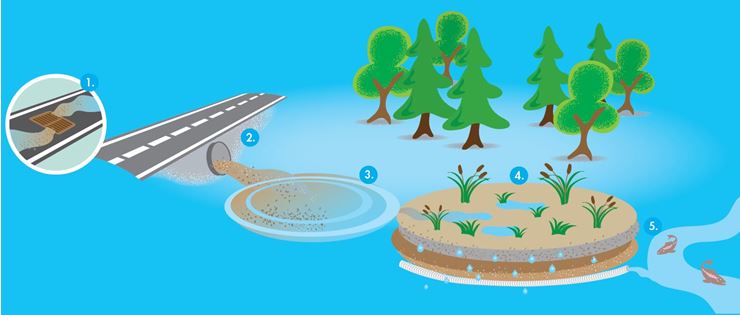
Illustration of the biofiltration principle. Stormwater collected in drains (1) is channelled to a sedimentation baisin (3) in which a large part of the solids (gravel and sand) sinks to the bottom. The stormwater then continues to the biofiltration area (4) where it is allowed to pool , giving the vegetation time to bind nutrients and heavy metals. After this, the water slowly permeates the filtrating sandy layers under the vegetation, during which harmful substances are absorbed by microbiological activity. Finally, the purified water is fed into a water recipient (5) or permeating the ground.
How to implement a natural stormwater solution?
Find tips and lessons learned from the CITYWATER project – read more here.
How to compare the social benefits and costs of storm water solutions?
Read about the cost-benefit analysis method and a stormwater case study here.
How to increase awareness on storm water issues?
Boost your communication with a strategical approach, read more here.
Extras
Extras
Guides and examples on sustainable storm water management and solutions
Urban rain – wasted in rain. Sustainable storm water solutions for greener cities. Brochure describing the sustainable solutions planned and constructed within the CITYWATER Project. Link_to_the_brochure.
Blue-green Fingerprints of Malmö
A book describing Malmö’s transition from a traditional urban drainage in buried pipes towards a sustainable urban drainage in open systems
Link to the book
Handbook on sustainable urban drainage systems
(D)rain project report
Link to the handbook
Fifth Dimension – Green Roofs in Urban Areas
LUOMUS, Finnish Museum of Natural History webpage on the University of Helsinki research group for sustainable green roofs.
Link to the report
Climate-Proof City – The Planner’s Workbook project web page
Link to the web page
Quality of storm waters in urban areas
Valtanen, M. Effects of urbanization on seasonal runoff generation and pollutant transport under cold climate. University of Helsinki.
PhD thesis on storm water quality.
Link to the thesis

